1923 Bentley 3 Litre
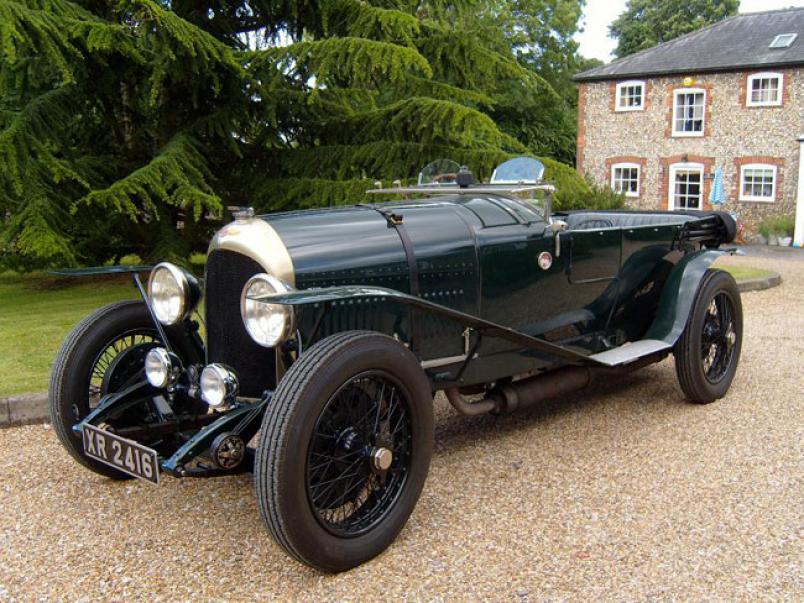 1923 Bentley 3 Litre
1923 Bentley 3 Litre
21 February, 2025
 1923 Bentley 3 Litre
1923 Bentley 3 Litre
In 1924 Duff and Clement returned in their 3 litre Bentley to Le Mans having qualified the previous year in the first stage of the Rudge-Whitworth Triennial Cup.
Their previous lap total was 128, comfortably exceeding their target of 79 by 41.8%, and a joint 4th position, but 16 laps behind the 1- 2 victory of Team Chenard-Walcker who had returned in force for the second leg.
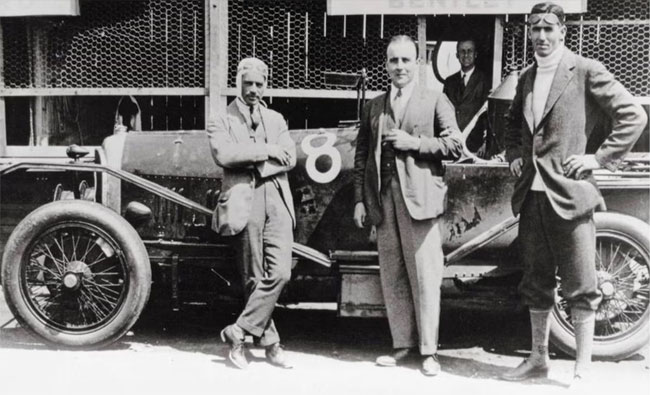
Frank Clement, Walter Owen Bentley and Captain John. E. Duff
As previously, the race was restricted to production cars, as opposed to “one-off”competition models, with a minimum output of 30 vehicles, the existence of which of which the manufacturers had to provide evidence, and the competing models had to be standard versions.
Although this was still a private entry by John Duff once again with Frank Clement, W.O Bentley was now fully on board and very supportive.
Upgrades
This year the Bentley 3 Litre Sport had hub brakes on all four wheels, the headlamps had protective wire mesh, and the petrol tank had more protection against punctures caused by flying stones that had cost the team 2 hours to repair in 1923.
Work had gone into reducing time when tackling potential repair issues that might arise and lookouts were posted at Mulsanne Corner so he could signal to them his intent to pitstop and they would phone ahead to alert the team.
In light of the weather during the inaugural race in 1923, the 1924 Race took place some three weeks later on the weekend of 14th and 15th of June, where it has remained ever since, affording longer daylight hours and the likelihood of more clement weather.
Updated Rules
Similarly repairs had to be done by the drivers only, so carrying tools on board was a necessity.
Raising the Bar
On the second year of Le Mans 24 Hour Endurance race the performance bar was raised from what had been an intentionally lenient initiation 13 months earlier.
In 1924 average speed was increased by 45%
Engine Size | 1923 Min Laps | 1924 Min Laps | Average Speed |
| 3500cc + | 82 | 119 | 85.6km/h |
| 3000cc | 79 | 115 | 82.7km/h |
| 2000cc | 70 | 102 | 73.4km/h |
| 1500cc | 63 | 93 | 66.9kmh |
| 1100cc | 52 | 85 | 61.1km/h |
1923 vs 24 Minimum Performance Requirements by Engine Size
The challenge is now more acute,but fragmented into beating the clock as well as your competitor.
Failure is not an option
If you finished within your engine size lap requirement you automatically qualified for the following years Le Mans, if not . . . .
When the wheels are not turning you are eroding your average lap time
What if it rains ? Rain impacts maximum speed and thus laps.
Tyres become a real point of focus.
How long to repair a puncture ?
How long does it take to raise your car hood after 5 laps and then after the required two lap duration, stop, get it inspected for robustness take it down and in doing so get rid of that extra drag ?
John Duff took around 40 seconds to put it up on the Bentley, but one of the 1099cc Sara's set the record at 27 seconds.
On a like for like arrival time, that consitutes standing still for 13 seconds whilst your competitor with a smaller engine, but a lighter car takes off.
Every kilometre above average km/h is time banked against scheduled and unscheduled stoppages.
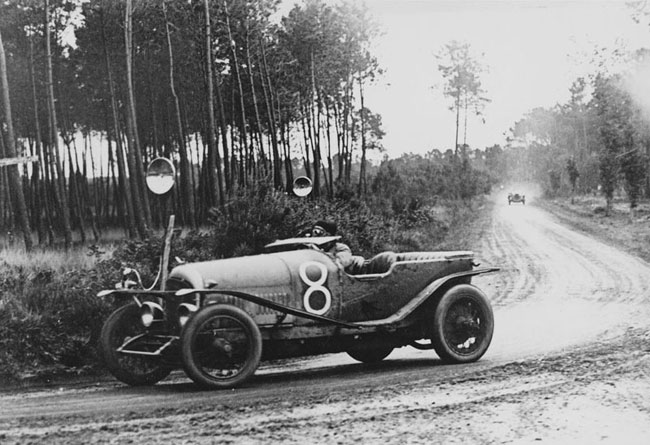
1924 Arnage Corner at Le Mans - Bentley Chassis 141
The weather was roasting!
The Duff and Clement entry, once agin in the 3 litre Bentley, was the sole Bentley and for that matter, the sole non French presence.
No Shows
Ettore Bugatti who had raced one of his two cars last year entered three T22's and two Type 30's but none turned up, apparently sidelined for the August Grand Prix in Lyon where they took 7th, 8th and 11th places in T35's, the winner being Giuseppe Campari in an Alfa Romeo P2.
Sunbeam entered for the first time, but then withdrew and took the same route as Bugatti coming 5th and 10th in Lyon.
A bit more insurance
The Chenard-Walcker team, winners of 1923 doubled their entry to six cars.
Bignan who took 3rd place previously bought an additional third car this year as did the SARA team with their 1098cc four cylinder air cooled engine.
Rolland-Pilain, winner of the 1923 San Sebastián Grand Prix, had entered two 1924cc cars, a 2.2L and a 2.3 L in the 1923 Le Mans entered four 1997cc S4 cars this year.
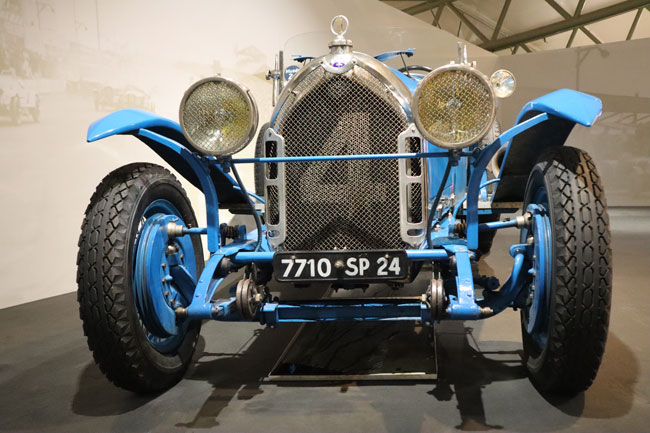
Lorraine-Dietrich B3 6
Lorraine-Dietrich repeated their 3 car entry moving up from a 3.4 to a 3.5 litre sports model designed for competition racing.
June 14th 1924 - 1600hrs
Forty one cars started the race in ferocious heat
As the race started the newly introduced 20 lap refueling rules caused casualties.
The fuel tank capacity of the four Rolland-Pilain 1997cc cars was too small to entertain aggressive driving and the demise on lap 18 of the first car signaled conservative driving to the rest, despite which a second car succumbed on lap 60.
One of the Bignan cars was disqualified, the crime; refilling the radiator prematurely (on lap 7) as a result of the radiator plug becoming loose.
Duff narrowly missed the same fate when he mistakenly came in to the pitstop to refuel at 19 laps only to be warned off by an official, but managed to make it back to the Bentley pitstop on the next lap.
Sixteen cars were out in the first quarter of the race, including the disqualification.
Frank Clement's 107.22km/h (66.69 mph) fastest lap of 1923 was beaten straight away first by one of the 3 litre Bignans which was then superceded by the André Lagache of the 1923 Chenard-Walcker winning team with 111.17 km/h (69.08 mph)
Pit problems very nearly ended the Bentley participation.
115 laps was the target for 3 litre engines to qualify.
After 120 laps driving neck and neck with the new Lorraine-Dietrich sports models and with timings between the remaining cars on the circuit much reduced compared to the previous year Duff came into the pits for a wheel change which proved difficult to remove.
By the time the Bentley was back on the road, it was calculated that relevant to their lap average of the first leg (1923) of the Rudge-Whitworth Cup, the delay rendered the equivalent of 5 laps to be below the statutory minimum making them ineligible to contribute to the Bentley race total.
So at three o'clock on Sunday 15th June with just one hours racing time left John Duff set of with a reduced total of 115 laps, no doubt welcomed by the remaining cars in the race competition.
In the end the Bentley team completed 120 valid laps, exceeding that of all other competitors despite traveling 125 laps.
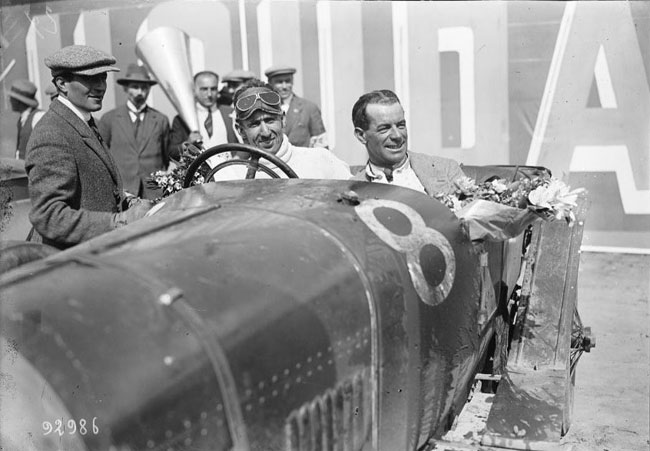
Captain John.E. Duff and Frank Clement 1924
But it was close
The first of the two Lorraine-Dietrichs, completed 119 laps with only half a lap between them.
Two Chenard-Walcker 2 litre cars completed 111 and 109 laps, but last years Chenard winners René Léonard and André Lagache were out after 26 laps when Léonard had to escape from the 3.9L S8 when it caught fire on the Mulsanne Straight and was destroyed.
14 of 41 cars completed the circuit, though an additional two completed the 24 hours but fell short of the minimum distance.
Bentley sales soared. The Brand had international acclaim.
They sold 700 vehicles in the two years following their win.
Their participation had cemented Le Mans Race as a racing fixture on the international map.
With the 3 Litre Bentley breaking records at home at Brooklands, winning the team prize at the 1922 Tourist Trophy on the Isle of Man, coming 4th at the inaugural Le Mans and winning the 1924 race it demonstrated not only reliability, but speed and from stock models.
More pertinently the 1924 Le Mans victory, rescued the company from its then current financial plight when Captain Woolf Barnato, a British financier, impressed by the 1924 win, invested £100,000 in the company.
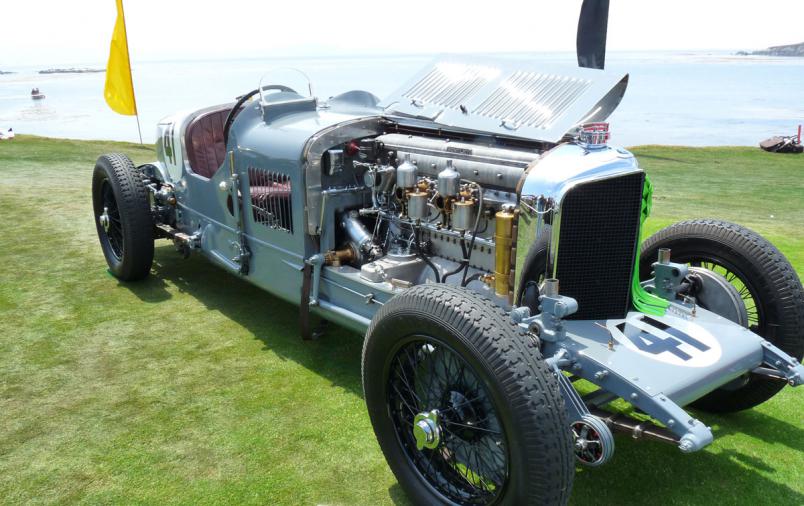
'Old Number 1' is a very famous Bentley Speed Six racecar, built specifically for competition.
It won the Le Mans 24 Hours twice, in 1929 and 1930, driven by Woolf Barnato, Tim Birkin, and Glen Kidston.
The car underwent constant modifications to stay competitive, including changes to its body for different races.
In the 1929 season, it also secured victories at the Brooklands Six Hour race and other podium finishes.